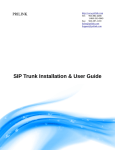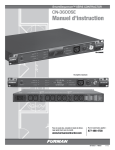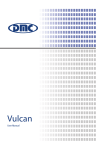Download IP/SIP Trunk Software User Guide
Transcript
PRILINK http://www.prilink.com Tel: 905-882-4488 1-866-261-0649 Fax: 905-597-1139 [email protected] [email protected] IP/SIP Trunk Software User Guide IP/SIP Trunk Software User Guide Table of Contents Overview....................................................................................................................................................3 Getting Started...........................................................................................................................................4 Installation.............................................................................................................................................4 Monitoring Site Status...........................................................................................................................5 Exploring Network Traffic.........................................................................................................................7 Traffic Summary....................................................................................................................................7 Analyzing Monthly Data for a Network Identity.....................................................................................10 IP Types...............................................................................................................................................11 SIP Trunks and Phone Numbers..........................................................................................................12 Analyzing Daily Data for a Network Identity..........................................................................................14 IP Types...............................................................................................................................................14 SIP Trunks and Phone Numbers..........................................................................................................17 Using your Network Table.......................................................................................................................20 Troubleshooting with Packet Capture......................................................................................................22 Exporting Raw Data and Reports.............................................................................................................23 Configuring SIP Trunk Alerts..................................................................................................................25 Rev. 61 2 IP/SIP Trunk Software User Guide Overview This guide documents Prilink IP/SIP Trunk Software Tool version 1.20.0. With this tool, network engineers and IT software developers can use a single PC to analyze Telco network traffic over 400 days and perform real-time troubleshooting using packet capture. The goal of this guide is to enable users to perform the following core functions: • Automatically scan all IP/SIP network identities and assign meaningful names to key items. • Analyze monthly and daily traffic and quality of service (QoS) for selected network identities. • Troubleshoot applications with hardware-timestamped packet capture. • Generate reports and export data for further processing with 3rd party tools. • Configure traffic alerts for proactive monitoring. To get further assistance or to answer any questions regarding the Prilink IP/SIP Trunk Software Tool, please contact Prilink support at 1-866-261-0649 or [email protected]. Important Terms The following terms are used repeatedly throughout this guide: A Site is a location within your network where a Base Unit has been installed (see Installation). Each base unit has a unique number (Site Number) and name. All base units communicate with a central Traffic Hub that temporarily stores data before it is transferred to the users' PC or server. The PrilinkNM application is a Windows-based software application installed on the users' PC or server that gathers data from the Traffic Hub for visualization and analysis. Units of Digital Information Bandwidth measurements are reported in bytes (B) and speed measurements are reported in bits per second (bps). Where prefixes are used to indicate multiples of bits or bytes (e.g. K, M, G), they are consistently used in the decimal sense (i.e. 1 KB = 1000 Bytes). Rev. 61 3 IP/SIP Trunk Software User Guide Getting Started Installation A Prilink Base Unit collects and analyzes IP traffic data by monitoring 10/100/1000 Ethernet circuits through its monitor ports. There are two methods for connecting to Ethernet circuits: using mirror / span ports or an Ethernet tap. Method 1: Mirror / Span Port 1. If available, configure your router to send a copy of network packets from your Telco to designated mirror/span ports. 2. Route a cable from designated mirror/span ports to the Prilink base unit monitor ports. Method 2: Ethernet Tap 1. Connect Ethernet cable from Telco to “Network” port B on the Ethernet tap. 2. Route a cable between “Network” port A and your router. Check the Link/Activity indicators on your equipment ports to verify that data is flowing through the tap with power disconnected. 3. Plug the Ethernet tap power supply into an available outlet. 4. Route cables between the “Monitor” ports of the Ethernet tap and the base unit. Finally, connect the LAN port on the base unit to your network. Using the power supply and cord included, connect the DC power port to an available outlet. Once powered on, the base unit will attempt to establish connection with the Traffic Hub. The status LED will begin to flash once connection is established. It normally takes approx 30s after boot up for the status LED to begin flashing. Rev. 61 4 IP/SIP Trunk Software User Guide Software Installation and Log-on PrilinkNM application software can be installed on any Windows based PC or server. Simply execute the prilinknm-1.20.0.exe installer that you downloaded when subscribing to Prilink IP/SIP Trunk Software Tool service. Once installed, start the PrilinkNM application: You will be prompted for a password to begin. Enter the password that was supplied to you when you subscribed to Prilink SIP trunk service. If you have forgotten your password, please contact Prilink support at 1-866-261-0649 or [email protected]. The application can be navigated almost exclusively with the keyboard, using the Esc (back), Enter, Arrow, and PageUp/PageDown keys. Monitoring Site Status After successful login, you will be presented with a table of sites that are equipped with a base unit: Rev. 61 5 IP/SIP Trunk Software User Guide Check the status line at the top of the screen to verify that you are communicating with the traffic hub (look for server: connected). For each site, the local clock time on the base unit is displayed beside site name, along with the amount of time it has been running. If a base unit has not established a connection with the traffic hub, its time will be blank. In this case, check that the status LED on the unit is flashing and that your software client shows server: connected. Next to local / run time is a live summary of the most recent 15 minutes of activity, combining all IP and SIP trunks monitored by the base unit. Included are bi-directional measurements of peak speed, total bandwidth, number of answered calls (sip ans), and number of not answered call attempts (sip not ans). If a site is idle for a full 15 minute interval (no IP traffic), then the IP alert column will display the total time that the site has been idle. Menu Use the up/down arrow keys to select a site and hit Enter to bring up the Site Status Menu (Note: Most screens have a menu of options that is accessed by the Enter key and can be closed by the Esc key). The options Traffic Summary, Network Table, Report and SIP Trunk Alert are documented in the following sections. Select Rename Site to change the site name. Select Exit to close the application (same as using the Esc key). Rev. 61 6 IP/SIP Trunk Software User Guide Exploring Network Traffic Prilink automatically scans several types of network identifiers at the Link, Internet, and Transport layers, and compiles statistics on each unique identity. The term traffic type or data type is used throughout this guide to refer to a specific type of network identifier. There are 6 traffic types: IP Trunk: Unique pair of MAC Addresses that have exchanged network traffic. IP: Unique IP address. IP – Port: Unique combination of IP address and transport layer port number. IP – IP: Unique pair of IP addresses that have exchanged network traffic. SIP Trunk: Unique SIP trunk identified by IP address and transport layer port number. SIP Number: Unique SIP address (phone number). Whenever a new network identity is detected that falls into one of the above types, the base unit begins recording various traffic metrics every 15 minutes. Users can browse the most active identities, assign meaningful names, view monthly or daily traffic and initiate packet capture on any individual identity. Traffic Summary Selecting option Traffic Summary from the Site Status menu provides access to the last 400 days of network traffic for the current site. Use the Esc key at any time to return to the Site Status screen. Rev. 61 7 IP/SIP Trunk Software User Guide The display is organized to show the most active network identities for all traffic types (use the PageUp/PageDn keys to cycle through all 6 types). Each column covers a 24 hour period as indicated in the column header. The first column covers the last 24 hours, while the remaining columns each cover a calendar day beginning at 12:00 AM. The columns are sorted by bandwidth (for IP traffic types) or call volume (for SIP traffic types). Each column can contain up to 100 items, which are displayed 25 items per page. Use the up/down arrow keys to navigate off the current page to access the full list. Use the left/right arrow keys to navigate forwards or backwards through time. A line found at the top of the screen displays the current traffic type and the identity selected: Current site Traffic type Selected item description and statistics The example on the left shows a typical column for traffic type IP. The most active IP addresses over the last 24 hours are shown. The vertical bar graph shows the percentage of total daily traffic represented by each IP address. The initial L preceding an address indicates that the address is considered Local or internal. The initial N stands for Network, indicating an external address. You can toggle Local/Network for a particular address as described in the Menu section. The example on the left shows a typical column for traffic type SIP Number. The most active SIP phone numbers for Wednesday March 25th, 2015 are shown. The vertical bar graph shows the percentage of total daily call volume represented by each number, broken down into answered (yellow) and not answered (red) calls. The int# / ext# labels preceding each number distinguish internal and external phone numbers. Rev. 61 8 IP/SIP Trunk Software User Guide Menu Hit the Enter key to bring up the Traffic Summary menu. Month: Analyze monthly data for the currently highlighted identity, as documented in Analyzing Monthly Data for a Network Identity. Day: Analyze daily data for the currently highlighted identity and date column, as documented in Analyzing Daily Data for a Network Identity. Select Date: Quickly navigate to any date in the last 400 days, a convenient alternative to using the left/right arrow keys to move one day at a time. Add to Network Table: Add the currently highlighted item to a user-customized list called the Network Table (more on this in section Using your Network Table). Capture Packet: Initiate packet capture using the currently highlighted item as a filter, as documented in Troubleshooting with Packet Capture. Switch Local/External: (Applies to IP traffic type only). Designate the currently highlighted IP address as a Local or Network (external) address. Properly identifying addresses as local or external makes it easier to interpret bidirectional statistics when aggregating data from multiple IP addresses together. Select Display: Display both IP and SIP traffic types (IP + SIP Summary) or IP traffic types only (IP Summary). The latter is useful to simplify the user interface if no SIP trunks are being monitored by the base unit. Return (Esc): Return to Site Status screen. Rev. 61 9 IP/SIP Trunk Software User Guide Analyzing Monthly Data for a Network Identity There are two ways to access monthly data for a particular network identity: • From the Traffic Summary screen, highlight an item with the arrow keys, hit Enter to bring up the Traffic Summary menu, and choose Month. • From the Network Table, highlight an item with the arrow keys, hit Enter to bring up the Network Table menu, and choose Traffic. Hit the Esc key at any time to return to the Traffic Summary or Site Status screen. Days of the Month The Month Traffic view is organized into 3 columns of information, with each row representing a day in the month. If viewing the current month, the top row represents the last 24 hours; all other rows cover a calendar day starting at 12:00 AM. Use the up/down arrow keys to navigate through the month, with the most recent day appearing at the top. The legend above each column will update to indicate the numeric values for each bar. A line found at the top of the screen displays the current site and the item selected: Current site Rev. 61 Item description 10 IP/SIP Trunk Software User Guide Menu The information in each column depends on the traffic type of the network identity selected, but all traffic types share a common menu. Hit the Enter key to bring up the Month Traffic menu. Day: Analyze daily data for the currently highlighted date, as documented in Analyzing Daily Data for a Network Identity. Select Month: Change the month on display to any month in the last 400 days. Return (Esc): Return to Traffic Summary or Site Status screen. IP Types The columns displayed in the Month Traffic view depend on the traffic type. For IP network identities (IP trunks, IP addresses, IP address + port combinations, and IP to IP connections), the columns are described below: The bandwidth column graphs the total number of bytes sent or received by the selected identity during each day. The speed column graphs the peak bit rate achieved by the selected identity during each day. The active 15-min column gives the total number of 15 minute intervals during which some network traffic was sent or received by the selected identity. Note the legend at the top of the speed and bandwidth columns to understand the direction of traffic represented by each bar. In the case of traffic types IP and IP – Port, in refers to traffic received by the identity and out refers to traffic transmitted by the identity. In the case of traffic types IP Trunk and IP – IP, the identities are defined by a pair of elements (MAC addresses for IP trunk and IP addresses for IP – IP). Labels A and B are assigned to each element of the pair, and an arrow is used to indicate the direction of traffic flowing between the elements (A ← B and A → B). Rev. 61 11 IP/SIP Trunk Software User Guide SIP Trunks and Phone Numbers The columns displayed in the Month Traffic view depend on the traffic type. For SIP network identities (SIP trunks and phone numbers), the columns are described below: SIP Trunks The circuit column graphs the maximum simultaneous calls reached during each day. The column header includes a breakdown of incoming and outgoing peaks. The second column graphs the total number of call attempts during each day, regardless of whether the calls were answered or not. Each bar is divided into incoming (blue) and outgoing (purple) calls. The number appearing to the right of each bar is total number of calls. The third column also graphs the total number of call attempts, except that bars are divided into answered (yellow) and not answered (red) calls. The number appearing to the right of each bar is total number of calls. SIP Numbers The call volume column graphs the total number of call attempts during each day, regardless of whether the calls were answered or not. Rev. 61 12 IP/SIP Trunk Software User Guide The second column splits call volume into answered (yellow) and not answered (red) calls. The number appearing to the right of each bar is the total call volume. The third column splits not answered calls into cancel (blue) and fail (purple). Cancel represents abandoned calls, while fail represents calls with a SIP response code in the range 4xx/5xx/6xx indicating failure. The number appearing to the right of each bar is the total number of not answered calls. Rev. 61 13 IP/SIP Trunk Software User Guide Analyzing Daily Data for a Network Identity There are two ways to access daily data for a particular network identity: • From the Traffic Summary screen, highlight an item with the arrow keys, hit Enter to bring up the Traffic Summary menu, and choose Day. • From the Month Traffic view, highlight a date with the arrow keys, hit Enter to bring up the menu and choose Day. Hit the Esc key at any time to return to the Traffic Summary or Month Traffic screen. In the Day Traffic view, the 24 hour period is divided into 15 minute intervals. Use the left/right arrow keys to move backwards and forwards in time. Note the vertical indicator line on any graphs in the display to see your current position in time. As you move through time, you will notice the numbers in the graph legends update to reflect the statistics for the selected 15 minute interval. Menu The contents of the view depend on the traffic type of the network identity selected, but all traffic types share some common menu options described below (further options that are traffic type-specific are documented in their relevant sections). Hit the Enter key to bring up the Day Traffic menu. Select Date: Change the date on display to any day in the last 400 days. Scale Auto/Fixed: Toggle between a fixed chart y-axis for all dates, or a y-axis that adjusts to maximum values for each date. Copy Data to Clipboard: Copy screen data to the clipboard in tab-separated text format, so that you can easily paste into spreadsheet applications like MS Excel. You can choose to copy only the 15 minute interval selected, or the full 24 hour period on display. Return (Esc): Return to Traffic Summary or Month Traffic screen. IP Types The contents of the Day Traffic view depend on the traffic type. For IP network identities (IP trunks, IP addresses, IP address + port combinations, and IP to IP connections), the view is split into bandwidth / speed charts and an IP connection table as shown below: Rev. 61 14 IP/SIP Trunk Software User Guide Bandwidth Connections Speed Each data point in the bandwidth chart is the total number of bytes transmitted or received by the identity during a 15 minute interval, while the speed chart shows peak bit rate achieved during the interval. Note the legend at the top of each chart to understand the direction of traffic shown. In the case of traffic types IP and IP – Port, “A ←” refers to traffic received by the identity and “A →” refers to traffic transmitted by the identity. In the case of traffic types IP Trunk and IP – IP, the label A is assigned to one of the pair of elements defining the identity. The table on the right side of the screen displays all IP sessions during the selected 15 minute interval. Use the up/down arrow keys to highlight different IP sessions Rev. 61 15 IP/SIP Trunk Software User Guide An IP session is an exchange of network traffic between two IP addresses uniquely defined by IP Protocol and port numbers (if applicable). In the figure above, the highlighted IP session represents UDP traffic between 192.0.2.242 (port 39785) and 203.0.113.222 (port 53). The bi-directional bandwidth used by each session is displayed alongside peak bit rate (speed). Port Scan When analyzing daily data for an IP address, it is possible to display a breakdown of traffic by port number for the 24 hour period being analyzed. Hit Enter to access the Day Traffic menu and choose option Port QoS 24 Hours (this option is only available for traffic type IP). Use the Esc key at any time to return to the Day Traffic view. Port Numbers The bandwidth, speed, and active 15 min columns are exactly as documented for the Month Traffic view for IP types (see Monthly Traffic for IP Types). Use the up/down arrow keys to select different port numbers detected (up to 32 ports per page). Hit the Enter key to access a menu of options: Sort by Port Number: Sort the display by port number (smallest to largest). Sort by Bandwidth: Sort the display by bandwidth (largest to smallest). Add to Network Table: Based on the currently highlighted port number and the IP address being analyzed, add an IP – Port identity to your Network Table. Rev. 61 16 IP/SIP Trunk Software User Guide SIP Trunks and Phone Numbers The contents of the Day Traffic view depend on the traffic type. For SIP network identities (SIP trunks and SIP numbers), the view is split into call volume / max circuit charts and a CDR table. SIP Trunks Call Volume Max Circuit Call Detail Records Each bar in the call volume graph represents the total number of call attempts in the 15 minute interval, subdivided into ■ Answered ■ Cancel (abandoned call) ■ Fail (SIP response code 4xx/5xx/6xx indicating failure) Rev. 61 17 IP/SIP Trunk Software User Guide Each bar in the circuit graph represents the maximum number of simultaneous calls reached in the 15 minute interval. The table at the bottom of the screen contains CDR for all calls in the 15 minute interval selected. Use the up/down arrow keys to scroll through the full list of records. The fields included in each record are as follows: Setup time: The time that the call was initiated. Trunk: The SIP trunk id. Dir: The direction of the call (incoming or outgoing). Int / Ext number: The phone numbers involved in the call (internal/private and external/public), including name display if available. Call state: Rev. 61 ■ ans release: The call was answered. In this case the duration of the call is added at the end of the record. ■ nAns cancel: The call was not answered, but not as as result of error. The client cancelled the request before a response was received (i.e. abandoned call). ■ nAns fail: The call was not answered as a result of a SIP failure response. In this case the SIP failure response code is added at the end of the record, along with the closest Q.931 equivalent. 18 IP/SIP Trunk Software User Guide The Day Traffic view menu for SIP trunks (accessed by hitting Enter key) features an option called Call Records / Summary. This option toggles between displaying individual CDR in the bottom table or an overall summary of the 24 hour period. In summary mode, the bottom table appears as follows: The left half of the table gives a breakdown of traffic based on call state, as well as the maximum simultaneous calls reached (maxTrk). The right half of the table gives a breakdown of failed calls based on SIP response code. SIP Numbers Call Volume The Day Traffic view for SIP Numbers is similar to SIP Trunks, except that it only provides a call volume chart and there is no Call Summary menu option. Call Detail Records Rev. 61 19 IP/SIP Trunk Software User Guide Using your Network Table The Network Table serves three main purposes: • to assign meaningful names to network identities appearing in the Traffic Summary screen. • to define new identities that may not appear in the Traffic Summary screen (because they are not active enough to fall in the top 100 in their traffic category). • to quickly access traffic data and initiate packet capture for any of the above identities directly from the Site Status screen. There are two ways to add new items to the network table; through the Traffic Summary screen and by manual definition. Adding Entries through Traffic Summary Any network identity appearing in the Traffic Summary screen can be added to the network table as follows: 1. Select the item with the arrow keys 2. Press Enter key to access Traffic Summary menu and choose Add to Network Table. When you add an item to the network table, you can also assign a meaningful name for quick visual identification. In the example below, we add our most active SIP number to our network table: Select an item with arrow keys and hit Enter. In the Traffic Summary Menu, choose Add to Network Table. Enter a meaningful name and hit Enter. Item name is updated in the Traffic Summary screen, and any other screen where the identity is referenced. Rev. 61 20 IP/SIP Trunk Software User Guide Manually Defining new Entries The second method of adding entries to the Network Table is performed from the Site Status screen by hitting Enter to bring up the Site Status menu and selecting Network Table. This sample network table has one item, created in the previous section via the Traffic Summary Use the up/down arrow keys to highlight a blank row, hit Enter to bring up the Network Table menu, and choose option Add. Select traffic type and enter criteria to define the new item. Menu In addition to adding new items, the Network Table menu includes several other options. Traffic: Analyze monthly data for the currently highlighted identity, as documented in Analyzing Monthly Data for a Network Identity. Edit: Edit name and definition for the currently highlighted identity. Add: Manually add a new identity to the Network Table (must have a blank row highlighted). Select traffic type (IP, IP – port, IP – IP, or SIP number). Enter criteria to define the new item, along with a meaningful name. Delete: Delete the currently identity from the Network Table. Capture packet: Initiate packet capture using the currently highlighted item as a filter, as documented in Troubleshooting with Packet Capture. Building up a detailed Network Table, either manually or through the Traffic Summary screen, can dramatically increase the effectiveness of several displays as meaningful names are used in place of addresses and numbers. The Traffic and Capture packet menu options fulfil the third purpose of the Network Table; to provide quick access to important network items without searching through the Traffic Summary screen. Rev. 61 21 IP/SIP Trunk Software User Guide Troubleshooting with Packet Capture Analyzing raw network packets is sometimes necessary to troubleshoot problems and gain insight into application operation. All of the network identities that are automatically scanned by Prilink can be used as filters for packet capture, alleviating the need to use complex filter syntax. Capture files are saved to the user's PC in Wireshark-compatible format for further investigation. There are two ways to initiate packet capture for a particular network identity: • From the Traffic Summary screen, highlight an item with the arrow keys, hit Enter to bring up the Traffic Summary menu, and choose Capture packet. • From the Network table, highlight an item with the arrow keys, hit Enter to bring up the menu and choose Capture packet. A Packet Capture window will open displaying capture meta data and status. The filter field indicates the network identity used to filter packets. The duration and file size fields are incremented as the capture progresses and more packets are added to the capture file. Capture will continue until a maximum file size is reached or until the user clicks the stop capture button. Once complete, the status field will reach “end” and the file name field will update to indicate the full path where the capture file is stored. Two files are created in the process: {site number}_{YYMMDD}_{HHMMSS}.pcap Raw capture file. {site number}_{YYMMDD}_{HHMMSS}.txt Text file containing all meta data from the Packet Capture window (filter, start time, duration, etc). It is possible to initiate packet capture on multiple sites simultaneously; a separate Packet Capture window will open for each site. Rev. 61 22 IP/SIP Trunk Software User Guide Exporting Raw Data and Reports All raw data for each site can be exported in CSV text format, and summary reports can be exported in CSV and PDF format. From the Site Status screen, use the up/down arrow keys to select a site, hit Enter to access the site Status menu, and choose option Report. You will be prompted to select a date to export. Each date is listed in YY Mon dd format. A 1 appears beside each date that has data available to export. A 0 indicates that no data is available to export, and choosing that date will not create any export files. Once a date has been selected, you will be prompted to browse for a folder to save reports. This is the folder in which the exported CSV and PDF files will be created. Once you hit OK and the report process completes, Windows explorer will open to display the files in the folder that you selected. There are up to 6 export files created. Each file name is prefixed with the date of the data contained in the file and the site name. The format of the date prefix is YYMMDD. e.g. “150225 SiteA Summary Report.pdf” for February 25th, 2015. The files created are summarized below: Summary Report.pdf A fully formatted PDF report with tables and graphs, containing a summary of the top IP trunks, IP addresses, SIP trunks and SIP numbers,. Summary Report.csv A text version of the above, with tables only. Comma delimited text file. IP Trunk Records.csv Raw 15-minute traffic data for each IP trunk. Comma delimited text file. IP CDR.csv Connection Detail Records for each IP session. Comma delimited text file. SIP Trunk Records.csv Raw 15-minute traffic data for each SIP trunk. Comma delimited text file. SIP CDR.csv Rev. 61 Call Detail Records for each sip call. Comma delimited text file. 23 IP/SIP Trunk Software User Guide Copy Data to Clipboard Most data displays in the PrilinkNM application include the menu option Copy Data to Clipboard. This option copies screen data to the clipboard in tab-separated text format, so that you can easily paste into spreadsheet applications like MS Excel for further reporting and analysis. Rev. 61 24 IP/SIP Trunk Software User Guide Configuring SIP Trunk Alerts Users can be alerted by E-mail and SMS when potential SIP trunk issues arise. From the Site Status screen, use the up/down arrow keys to select a site, hit Enter to access the site Status menu, and choose option SIP Trunk Alert. Hit Esc at any time to return to the Site Status screen. Alert definitions are outlined in the Settings section, while current alert status is indicated in the Status Panel section. For each alert type, a red light in the status panel indicates that alert conditions are currently being met. The Last Alarm column indicates the most recent date and time that alert conditions were detected, and Last Notification indicates the most recent date and time that an SMS/E-mail notification was sent. Menu Hit the Enter key to bring up the Alert menu. Edit Alert Settings: Change or review alert definitions, see section Types of Alerts below for more details. Return (Esc): Rev. 61 Return to the Site Status screen. 25 IP/SIP Trunk Software User Guide Types of Alerts There are 3 major types of alerts. To change or review alert definitions, hit Enter to access the Alert Menu and choose option Edit Alert Settings. For each alert, there is a checkbox that indicates if SMS/E-mail notification is enabled, along with a brief description of the alert. Call Blockage Alert This alert is intended to notify users in the event of high call blockage. At the end of every hour, an alert is raised if both of the following hold: • the percentage of unanswered calls during the hour was above a user defined minimum AND • the total number of call attempts during the hour was above a user defined minimum In the example above, an alert is raised if more than 10 calls are attempted in an hour and more than 1% are not answered. Peak Circuit Alert This alert is intended to notify users in the event of high network utilization. An alert is raised immediately when the number of simultaneous calls exceeds a user defined maximum. In the example above, an alert is raised when the number of active calls exceeds 10. Traffic Pattern Alert This alert is intended to notify users when call volume deviates from expected patterns. Up to 2 traffic patterns can be defined (labelled traffic 0 and traffic 1). At the end of each hour, an alert is raised if the following holds: • the hour falls in a user defined time period based on weekday and hour AND • the number of calls during the hour was below a user defined minimum OR • the number of calls during the hour was above a user defined maximum In the example above, an alert is raised only on weekends (Sat-Sun, all hours) if the number of calls during an hour is less than 100 or more than 150. Rev. 61 26




































